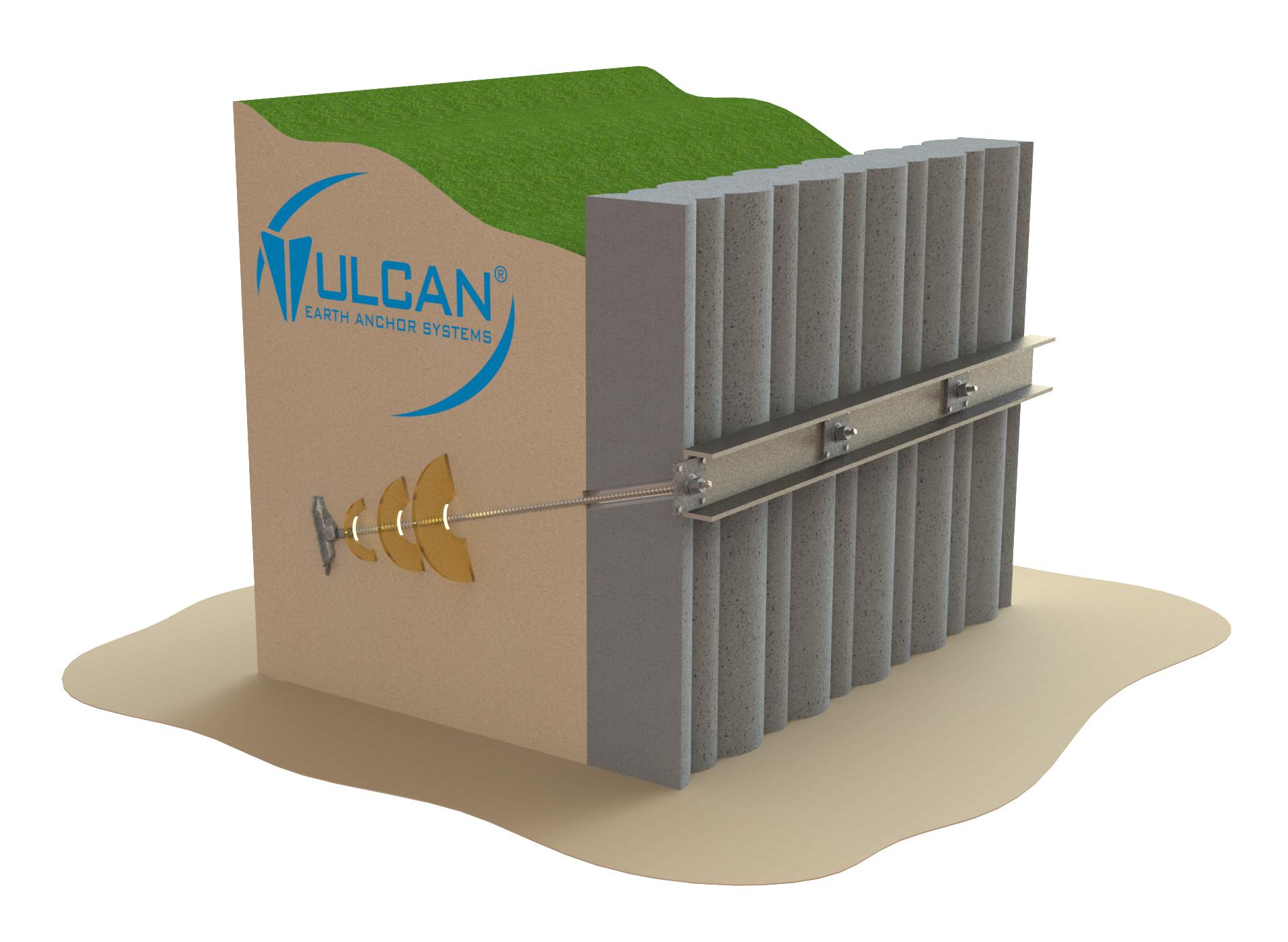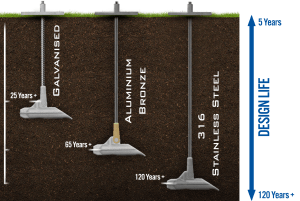Exactly How Durable Earth Anchors Work: A Comprehensive Guide to Soil Anchoring Solutions
Durable Earth supports play an essential function in supplying security and support in numerous building applications. By installing deeply into the ground, they stand up to lateral and upright pressures successfully. Various kinds of supports cater to different dirt problems, making them versatile. Recognizing their mechanics and installation strategies is vital for making best use of performance. What variables affect their effectiveness, and how do they contrast to typical techniques? The answers might shock you.
Recognizing Heavy-Duty Earth Anchors
Heavy-duty Earth anchors offer as vital parts in various building and construction and landscape design jobs, providing stability and assistance in tough soil conditions. These anchors function by being embedded right into the ground, where they resist lateral and vertical forces. Their layout permits safe add-on to frameworks, ensuring they remain secured versus soil activity or external loads.The performance of durable Earth anchors mostly depends upon the kind of soil and the anchor's installation deepness. Appropriate setup techniques are critical, as they determine the anchor's holding capability. Ecological aspects, such as moisture and freeze-thaw cycles, can additionally influence performance.These supports are regularly utilized in applications ranging from securing fencings and retaining wall surfaces to supporting momentary frameworks during negative weather condition conditions. Understanding the principles behind durable Earth supports is necessary for specialists seeking to enhance the sturdiness and safety of their jobs.
Sorts Of Heavy-Duty Earth Anchors
Various types of durable Earth supports are made to meet details needs based on soil problems and job needs. Helical anchors, featuring screw-like blades, work in softer soils, using high lots abilities and simple setup. Driven supports, which are hammered into the ground, appropriate for rocky terrains and supply instant tons assistance. Tie-back supports are generally made use of in maintaining wall surface applications, allowing for side support by anchoring right into the ground at an angle. An additional type is the cast-in-place support, perfect for concrete applications, as they are incorporated right into foundations for boosted security. Soil screw anchors are versatile choices that can be used in numerous soil types, supplying trusted tension and compression capacities. Each type serves distinct applications, making certain security and safety and security in building and landscape design jobs. Understanding these options enables for informed choices in choosing the ideal Earth securing remedy.
The Mechanics of Dirt Anchoring

Understanding the mechanics of dirt anchoring calls for an examination of various types of Earth supports and their installment techniques. Each anchor type provides unique qualities that affect its efficiency in different dirt conditions. Correct installation techniques are essential for maximizing the securing system's stability and performance.
Kinds of Earth Anchors
Earth anchors, necessary components in soil anchoring systems, come in a number of types, each designed for details applications and soil conditions. The most common kinds consist of screw anchors, which are turned into the ground, providing solid lateral resistance. Helical supports include blades that permit effective installment in various dirt types, making them appropriate for both short-term and irreversible applications. Driven anchors, commonly made from steel, are inculcated the soil and are effective in thick or rough settings. Auger supports use a helical style to facilitate setup in softer dirts. Plate anchors consist of a flat plate buried horizontally, distributing lots over a larger location, ideal for applications calling for high lots abilities in cohesive dirts.
Setup Techniques Explained
Correct setup methods are vital for the performance of soil anchoring systems. The process usually begins with site assessment, validating the chosen place can support the support's load. After determining the correct support type, correct hole deepness and angle must be developed. The installation entails driving the anchor right into the ground utilizing specialized devices, such as hands-on or hydraulic motorists, to accomplish ideal embedment. Post-installation, tensioning the anchor is important to guarantee stability; this is commonly verified with load screening. In addition, surrounding dirt problems ought to be monitored to stop variation. Following these methods not only boosts the anchor's performance however also lengthens its lifespan, offering reliable support for different applications.
Applications of Heavy-Duty Earth Anchors
While heavy-duty Earth anchors are commonly associated with building and construction and landscaping, their adaptability extends to a range of applications across different markets. In civil engineering, they supply crucial support for preserving wall surfaces, making certain security in areas prone to soil erosion. The marine sector uses these supports Check This Out for protecting anchors and marinas, stopping motion triggered by currents and tides. Additionally, in the telecom sector, sturdy Earth supports are considerable for maintaining cell towers and various other high frameworks against wind forces. Agricultural applications also benefit, as these anchors can secure frameworks like greenhouses and animals fence, ensuring they stand up to severe weather. In eco-friendly power jobs, such as wind ranches, Earth supports play a vital function in securing generator structures, boosting general safety and efficiency. This broad variety of applications highlights the flexibility and dependability of heavy-duty Earth supports throughout various areas.
Advantages Over Typical Anchoring Techniques
Although standard anchoring approaches have actually long been trusted for stability, durable Earth anchors supply significant benefits that improve performance and performance. One significant benefit is their exceptional load-bearing ability, which allows them to withstand higher pressures without failure. This toughness makes them suitable for demanding applications, such as in building and construction and energy installations.Additionally, sturdy Earth anchors are designed for much deeper installation, offering greater security in various soil conditions, consisting of sandy or loosened dirts. Their resistance to rust and ecological aspects guarantees a longer life-span and minimized maintenance expenses compared to conventional methods.Moreover, these anchors can be set up with marginal disruption to the surrounding location, protecting the integrity of the landscape. In general, sturdy Earth anchors provide a trusted and reliable option for securing requirements, going beyond the constraints commonly related to traditional anchoring techniques.
Installation Process and Best Practices
The installment procedure for soil securing remedies try this starts with comprehensive prep work and website assessment to guarantee peak performance. Following this, a step-by-step setup guide provides clear guidelines for reliable application (Manta Ray anchors). Complying with these best methods is important for attaining resilient and trusted anchoring results
Prep Work and Website Analysis
Reliable prep work and detailed website analysis are vital actions in the setup of dirt anchoring solutions. Before setup, the soil type have to be assessed to establish its bearing ability and suitability for securing. Carrying out a geotechnical survey can supply important information regarding soil composition, moisture levels, and potential ground motion. Furthermore, determining existing structures, greenery, and energies is essential to avoid disturbance during installment. The area needs to be free from debris and barriers to ensure secure gain access to for tools. Climate condition ought to additionally be kept an eye on, as adverse problems can affect both safety and installation efficiency. By diligently preparing the site and reviewing all appropriate variables, the possibility of effective anchor performance is significantly raised.
Step-by-Step Setup Overview
An extensive installment process is crucial for achieving optimal efficiency of dirt anchoring remedies. The installment begins with choosing the ideal support type and ensuring the website is free from particles. Next off, appropriate hole placement is established based on load demands. As soon as the location is developed, openings are pierced to the defined depth and size using the appropriate tools. The support is after that inserted into the opening, ensuring it is aligned appropriately. After securing the anchor, soil is backfilled and compacted to enhance security. It is important to comply with maker standards throughout the procedure. A post-installation assessment verifies that the anchors are sufficiently positioned and working as meant, offering dependable support for the intended application.

Upkeep and Examination of Earth Anchors
Routine maintenance and evaluation of Earth anchors are vital for making sure lasting performance and stability. Periodic checks allow for the very early detection of problems such as deterioration, loosening up, or dirt motion. Inspectors must look for signs of corrosion or deterioration on the anchor components, particularly at the connection factors. Additionally, the surrounding soil must be assessed for disintegration or changes in dampness web content, which can impact support effectiveness.It is recommended to develop a regular evaluation timetable, preferably a minimum of as soon as a year, depending upon ecological problems. Throughout evaluations, all visible parts need to be cleaned up to get rid of dirt or particles that might hide prospective problems. Any type of indications of distress, such as turning frameworks or unusual settling, must motivate instant evaluation. Proper documentation of assessments can assist in monitoring support efficiency gradually and facilitate timely maintenance actions, ensuring the supports continue to be trustworthy and practical.
Regularly Asked Inquiries
What Products Are Heavy-Duty Earth Anchors Commonly Made From?
Sturdy Earth supports are normally built from resilient products such as galvanized steel or stainless-steel, making certain stamina and resistance to rust. These materials supply resilient support and stability in numerous soil problems and applications.
How Do Soil Problems Impact Anchor Efficiency?
Soil conditions substantially affect anchor efficiency. Variables such as dirt type, dampness material, and compaction affect why not check here the support's hold and stability, with natural soils usually offering much better resistance than sandy or loosened dirts, affecting overall efficiency.
Can Heavy-Duty Earth Anchors Be Reused After Elimination?
Heavy-duty Earth supports can be reused after elimination, offered they are inspected for damage and wear. Correct cleansing and upkeep enhance their durability, ensuring efficient efficiency in subsequent setups when problems enable for secure reinstallation.
What Are the Environmental Impacts of Making Use Of Earth Anchors?
The environmental effects of making use of Earth anchors include prospective soil disruption, disruption of local ecosystems, and possible contamination of groundwater. If made use of properly, their benefits often surpass these concerns, promoting stability in different applications.
Exactly how Do I Pick the Right Support for My Project?

Comments on “The Science Behind soil anchoring solutions in Infrastructure Projects”